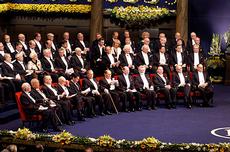Nobel Prizes thanks to innovation boosts
Finding attention for new discoveries or innovations is much harder for ‘no names’ than for renowned researchers. A new study reveals how and why novelties can nevertheless manage to overhaul established theories. The underlying boost effect identified by the researchers can also distinguish Nobel prize winners from normal scientists.

“For whoever hath, to him shall be given” is a popular quote from the Gospel of Matthew, which is often referred to in sociology as the ‘Matthew effect’. The observation that the rich get richer also extends to scientists: anyone who has managed to attract attention is cited even more frequently. Citations are to scientists like bonuses to bankers or a round of applause to artists – a sizeable pat on the back for a job well done. After all, only someone who has made a key contribution to research will get a mention in other scientific publications.
Innovation in science
A group of researchers headed by ETH-Zurich professor Dirk Helbing from the Chair of Sociology teamed up with scientists from the Institute for Scientific Interchange (ISI) in Italy to investigate how innovation in science works. How do new findings win through and even trigger a paradigm shift? It ultimately comes down to the question as to how a scientist carves out a career and becomes an eminent authority in a particular field.
To answer these questions, the scientists identified the ‘boost effect’ for groundbreaking publications using data from over one hundred Nobel Laureates who won the prize in different scientific disciplines between 1990 and 2009, and together have chalked up a staggering total of around two million citations. For all of these scientists, Helbing and his team found peaks, so-called ‘boosts’, that revealed a sudden change in the citation frequency of the scientists in question. These boosts can clearly be attributed to groundbreaking publications and go hand in hand with the researchers’ scientific breakthroughs. Although epochal publications are rare, some of the Nobel Prize winners even created several boosts.
Sand piles and citation avalanches
Interestingly, the study also shows that innovation in science follows the laws of a ‘self-organised critical system’. Helbing compares this to a sand pile, on top of which more and more sand is poured. The sand doesn’t flow down the sides evenly; instead, there are ‘avalanches’ of varying sizes. They represent the citation cascades that can be triggered by scientific publications. The small ones are frequent and typical for steady scientific progress – like pieces in the mosaic of knowledge; the scarce large avalanches, however, represent scientific breakthroughs or even revolutions. ‘Major events like this can overcome the Matthew Principle,’ says Helbing. ‘This is the only way for a revolutionary finding to win through from time to time.’
Spotting talent early on
Upon closer analysis, the data revealed that the success of great discoveries also has a feedback effect on older publications. Helbing and his team concluded that the ‘boost effect’ draws the attention of colleagues to the researcher’s entire body of work, thereby enhancing the latter’s reputation. Based on this observation, the team defined a ‘boost factor’ which measures the boost effect of the scientist in question and can also be used to identify talented scientists at an early stage. Up to now, it has often taken years for a budding scientist to get noticed on the basis of his or her citation count. However, ‘The considerably more sensitive boost factor can predict the potential future success of a scientist right after an excellent research result,’ says Helbing. The boost factor could also help spot potential Nobel Prize winners, the scientists suggest in their publication in PLoS One. However, it is by no means a fail-safe method of predicting winners; after all, it is well-known that the award depends on various other factors besides the citation frequency, not least the composition of the jury.
Important Element to Build an Innovation Accelerator
The discovery of the boost factor will be a valuable element of the so-called Innovation Accelerator, which is planned to be built within the FuturICT project. The innovation accelerator will help business people, politicians and scientists to find the best experts for a project, support the communication and flexible coordination in large-scale projects, co-creation, and quality assessment. New trends will be discovered earlier on, allowing the investment into emerging technologies. Once it is funded, FuturICT will be a huge so called EU flagship project (see also ETH Life article 04.05.2011).
Further reading: Mazloumian A, Eom Y-H, Helbing D, Lozano S, Fortunato S (2011) How Citation Boosts Promote Scientific Paradigm Shifts and Nobel Prizes. PLoS ONE 6(5): e18975. doi:10.1371/journal.pone.0018975







READER COMMENTS